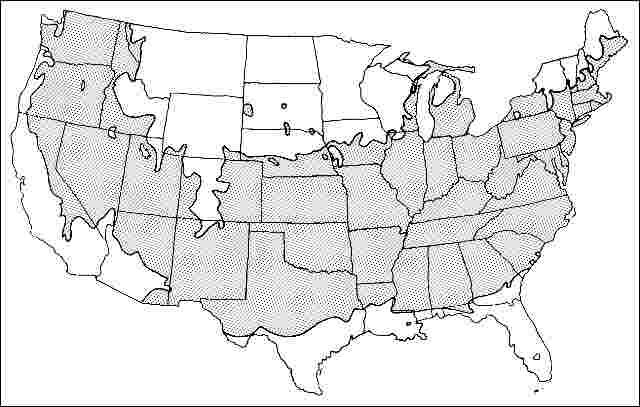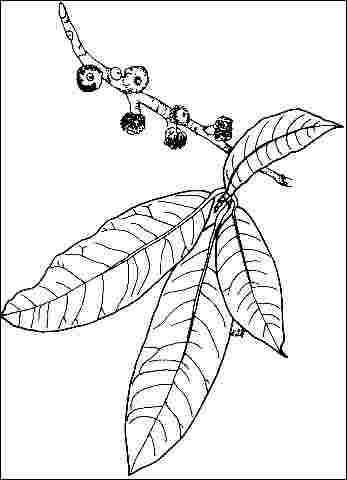Introduction
This stately, deciduous, native tree grows 40 to 60 feet tall (occasionally 80 to 100 feet) with an equal or greater spread, its broad, strong branches casting medium to deep shade below the rounded canopy. The smooth, 4- to 6-inch-long by 1- to 2-inch-wide leaves start out life with a red to yellow cast, deepen to a rich green through the summer, then turn shades of yellow and rust again in the fall before dropping. Some leaves will persist on the tree throughout the winter. In May or early June the flowers appear as drooping yellowish-green catkins and are followed by the production of one-half to one-inch-long, dark brown acorns.

Credit: Ed Gilman, UF/IFAS
General Information
Scientific name: Quercus imbricaria
Pronunciation: KWERK-us im-brih-KAIR-ee-uh
Common name(s): Shingle oak, northern laurel oak
Family: Fagaceae
USDA hardiness zones: 5A through 8A (Fig. 2)
Origin: native to North America
Invasive potential: little invasive potential
Uses: street without sidewalk; specimen; shade; parking lot island > 200 sq ft; tree lawn > 6 ft wide
Availability: somewhat available, may have to go out of the region to find the tree

Description
Height: 40 to 60 feet
Spread: 40 to 60 feet
Crown uniformity: symmetrical
Crown shape: pyramidal, round, oval
Crown density: dense
Growth rate: slow
Texture: medium
Foliage
Leaf arrangement: alternate (Fig. 3)
Leaf type: simple
Leaf margin: undulate, sinuate/undulate
Leaf shape: lanceolate, oblong, elliptic (oval)
Leaf venation: pinnate, reticulate
Leaf type and persistence: deciduous
Leaf blade length: 2 to 4 inches, 4 to 8 inches
Leaf color: green
Fall color: yellow, red
Fall characteristic: not showy

Flower
Flower color: brown
Flower characteristics: not showy
Fruit
Fruit shape: oval, round
Fruit length: .5 to 1 inch
Fruit covering: dry or hard
Fruit color: brown
Fruit characteristics: attracts squirrels/mammals; not showy; fruit/leaves a litter problem
Trunk and Branches
Trunk/bark/branches: branches droop; not showy; typically one trunk; thorns
Pruning requirement: little required
Breakage: resistant
Current year twig color: green, brown
Current year twig thickness: thin
Wood specific gravity: unknown
Culture
Light requirement: full sun
Soil tolerances: clay; sand; loam; slightly alkaline; acidic; extended flooding; well-drained
Drought tolerance: high
Aerosol salt tolerance: high
Other
Roots: not a problem
Winter interest: yes
Outstanding tree: yes
Ozone sensitivity: tolerant
Verticillium wilt susceptibility: resistant
Pest resistance: resistant to pests/diseases
Use and Management
The wood of shingle oak is extremely durable and was used in pioneer days for split shingles. This strong, resilient nature of shingle oak and its pyramidal shape when young help to make it suited to use as a screen, or a durable street or specimen tree which is unlikely to be damaged by harsh winds or snow-loads. It can be planted along residential streets, but there are more adaptable trees for downtown areas.
Naturally found along streams or river banks, shingle oak should be grown in full sun and prefers moist but well-drained, acid soils though it will adapt to moderately drier conditions and slightly alkaline soil. It is tolerant of wet sites once established. Field-grown trees should be transplanted in springtime for best survival.
Propagation is by seed.
Pests
Some pests of this oak are borer, variable oak and oak slug caterpillar although natural enemies usually provide control.
Diseases
Twig gall leaf miner and powdery mildew are common diseases fo this tree. Shingle oak is also susceptible to oak wilt.